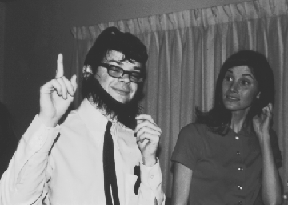1978-82: Technology Growth
No sooner was the graduate curriculum revision of 1976 well entrenched than we began to question what we had done. A major impetus was the Graduate School's decennial review, in March 1979, of our graduate programs. We began with an internal evaluation report, which Fred wrote, and we continued by discussing issues during a two-day visit by Richard Conway of Cornell and Ed Feigenbaum of Stanford. Later we received a written report from the reviewers and in September filed a written Departmental response.The reviewers found "a superior professional Masters Degree program . . . achieved at a very high price in faculty energy and diversion from research. The doctoral program is competent but uninspiring." and "The Department does not demand substantial research from its Faculty, and probably does not provide an environment that allows it." They made four principal suggestions: (1) redefine the thesis requirement for the M.S.; (2) shorten the list of required course topics; (3) be less concerned about details of teaching; and (4) give less instruction in small sections.
We acted on (1) by making the thesis optional, as discussed earlier, and on (4) by dropping small sections. We also began in Fall 1980 to implement joint courses with Duke, with each department teaching two courses taken by students from both. Van pools were arranged. Although there was some saving in faculty time, there was substantial loss in student time, and the arrangement had a short life.
We disagreed with the reviewers on concern for teaching and were unwilling to make substantial changes to the set of core courses. Indeed, it was not until the curriculum revision of 1994 that we reduced the core to 15 hours of courses. We did take to heart, however, the comments about research and the doctoral program. Over the ensuing years we further developed these activities substantially. I credit this development to the influence of the decennial review.

Jim Sneeringer as Steve Pizer; Cheryl Sneeringer as herself. (Photo: Mike Pique, © Department of Computer Science, UNC-Chapel Hill)
During the Spring semester of 1978-79, Rik Vantilborgh visited from the Philips Research Laboratory in Brussels. Earlier that same year, we were joined by Henry Fuchs, who had been a student of Robert Plummer in the computer graphics program at Utah before teaching at the University of Texas at Dallas. Henry filled the void created by the loss of Foley and Wallace, and is with us still; in 1988 he was named Federico Gil professor.
In 1979-80, with Don Stanat on leave at IBM in California, Mehdi Jazayeri in his last year was joined by Carlo Ghezzi, visiting for one year from the Politecnico di Milano. The visit led to the collaboration on their textbook on programming languages. It was also Dave Parnas's last year in our classrooms. Although he continued to hold an appointment, he moved his base to IBM and the Naval Research Laboratories.
That year also saw the birth of MCNC, intended both to facilitate graduate education in microelectronics at several universities and to assist the N.C. Department of Commerce in recruiting high-technology industry to the state. In July 1980 the state Budget Office authorized the establishment of a special program at UNC-CH in microelectronics, funding positions for five research professors, one research assistant professor, four research associates, and three secretaries, and a modest non-personnel budget. With MCNC technical support, Henry Fuchs taught in 1980-81 the first microelectronics design course offered in North Carolina.
Year 1980-81 brought three short stays. John Hedstrom visited for the year from UNC-Charlotte. Robert Young took a tenure-track position but left after one year in a career decision to leave academia. Lynn TenEyck, our first research faculty member, came as the GRIP project's first resident biochemist, and stayed for two years.
Year 1981-82 brought three long stays, as well as another short one. Neil Weste held a part-time research faculty appointment while serving as vice- president of MCNC. Bharat Jayaraman and Rick Snodgrass filled tenure-track positions. Bharat was our second Utah graduate, and specialized in programming languages, particularly declarative languages. Rick came from Carnegie Mellon, where he had done research in human-machine communication and in monitoring distributed systems. Bringing 16 years of engineering experience in the Pacific northwest, Vern Chi came to establish the Microelectronic Systems Laboratory (MSL), which he still directs.
Next Section: "Computer and Communication Facilities"